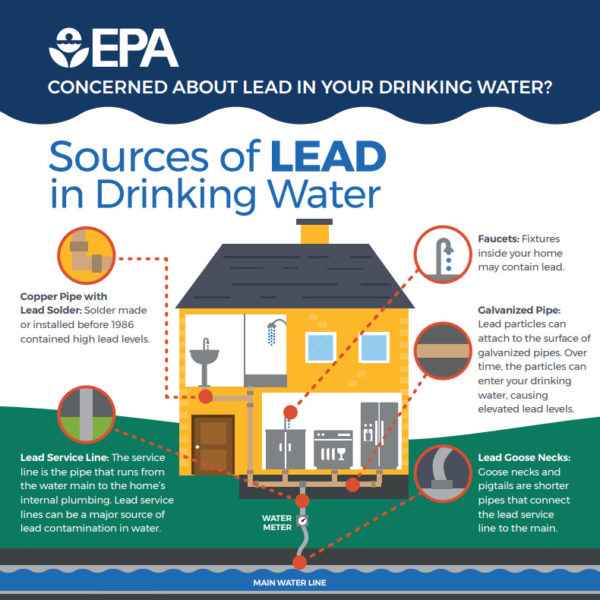Where does lead in drinking water come from?
Plumbing systems of older homes built in the early 80s and before used materials that are now recognized as dangerous to your health. Whether these materials are 100% lead or contain traces of the chemical element, they are responsible for poisoning your drinking water as they corrode.
Corrosion occurs when a chemical reaction between the water and the metal causes the metal to dissolve or wear away. The rate or speed of corrosion is affected by the mineral composition of the water, its acidity, and its temperature as well as the presence of protective coatings. As pipes corrode, rust builds up within the waterlines, resulting in the buildup of lead that is then released into the water supply. Your drinking water can become contaminated with lead if the following plumbing materials exist in your home:
Lead Piping & Materials
The United States Environmental Protection Agency (EPA) reports the most common sources of lead that contaminate drinking water are lead pipes along with faucets and fixtures containing the harmful chemical. Other sources include service lines made of lead as well as lead solder used to create a permanent bond between copper piping, brass faucets, and chrome-plated brass faucets. As these materials age and corrode, increasing levels of lead may find its way into your drinking water. Any plumbing materials found in the home to be made of or that contain lead should be immediately removed and replaced.
Galvanized Piping
Lead can also dissolve into your water supply as a result of corroded galvanized piping. This type of piping was popularly used after WWII through the 1960s since it was a cheaper and hardier choice to replace lead pipes. Galvanized pipes are simply a steel pipe coated in an outer layer of zinc to act as a protectant. However, zinc is vulnerable to corrosion, and rust build-up is inevitable. To prevent lead from leaking into your drinking water, galvanized piping should be replaced. Click here to learn more about replacing galvanized pipes.
EPA: Sources of Lead in Drinking Water
The EPA has provided a comprehensive resource to help you identify sources within your home that may be contaminating your drinking water with lead:
What are the health effects of lead in drinking water?
The continual consumption of water that contains lead results in lead poisoning. As the chemical element builds up in the body over time, it triggers serious health consequences in both children and adults ranging from fatal cardiovascular diseases to cognitive impairments. The EPA set a maximum contaminant level goal (MCLG) of 0 for lead in drinking water, setting the standard that no amount of exposure to lead is safe for the human body.
Children are Highly Susceptible
Fetuses, infants, and children make up the population most susceptible to developing physical and behavioral impairments caused by lead poisoning. Compared to adults, the consequences of lead exposure develop within children at a much lower exposure rate. Health effects include:
- Damage to the nervous system
- Development of learning disabilities
- Loss of hearing
- Impaired production/function of blood cells (Anemia)
- Delayed growth
- Behavior problems and hyperactivity
Symptoms of Lead Poisoning
Lead poisoning can manifest in many ways, and as the chemical builds up within the body, there are common symptoms that typically occur. Signs that indicate poisoning include:
- Headaches
- Abdominal pain
- Joint and muscle pain
- Difficulty concentrating
- Memory loss
- Irritability and fatigue
- High blood pressure
- Appetite loss
How do I detect lead in my water?
There are two key methods that will help you detect lead in your drinking water. You’ll not only be able to determine the exact amount of lead present, but you’ll also be able determine the likelihood that your water supply is contaminated:
- Test your drinking water. The only way to accurately detect lead in your water is to test it. While there are kits available that allow you to complete the test yourself, it’s recommended to send the sample to a credible third-party lab such as a state-certified laboratory, water filtration company, or your local water supplier. They will be able to provide in-depth details about the levels of lead and other harmful chemicals in your water.
- Determine the type of pipes in your home. Although this will not confirm the amount of lead in your drinking water, some types of piping contribute to significantly higher levels of the chemical element than others – such as lead and galvanized steel. Locate a pipe within your home and scratch the outside with a coin. If the material is a dull gray that’s also soft, then the pipes are made of lead. If the color revealed by the scratch is a silver gray, then the pipes are galvanized steel. You can also confirm the material of the pipe by using a magnet as it will only stick to galvanized pipes.
How can I prevent lead poisoning?
If your drinking water has tested positive for lead, then there are a few actions you can take to limit your exposure and prevent lead poisoning:
- Cook with and drink only cold water from the tap as lead dissolves more easily in hot water
- Drink bottled water or purchase a water filter designed to reduce lead levels
- Flush out water that may contain lead by running the tap for 30 seconds to 2 minutes before use
- Clean the faucet aerator every few months to remove lead particles
The most important step, however, to preventing lead poisoning is to replace all plumbing fixtures that contain lead. If you have determined that your pipes are made of lead or galvanized steel, then you have a greater risk of developing lead poisoning. The house should be repiped with PEX, a safe piping material that resists corrosion.
Free Home Piping Inspection
At The Repipe Company, our specialists are equipped with the knowledge and materials to inspect your home’s piping. If we discover lead in your plumbing system, then we’ll provide you with the solution you need to keep your family safe. As a local business, we’re happy to serve residents in and around Houston. Contact us today to schedule your free in-home inspection!






